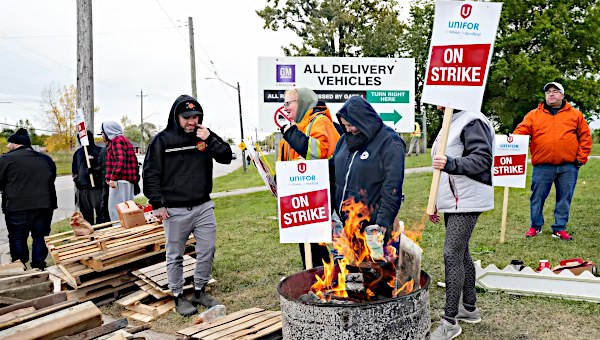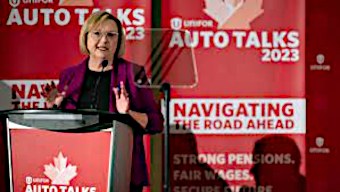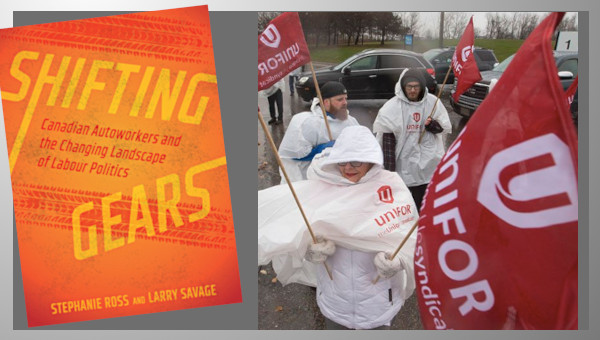Similar Challenges, Different Narratives: A Tale of Two Unions
The 2023 auto bargaining between the auto unions and the Detroit “Big 3” is shaking out to be different in a way that few of us could have imagined.
The objective conditions favour an environment of working-class gains, with some countervailing factors. Job markets favour workers, despite a post-COVID inflationary period and high interest rates used to force neoliberal levels of inflation. Workers across the economies of both the US and Canada have been looking to make up for the huge losses resulting from previous concessions (since the early 2000s and inflation and the recent inflationary period).
The strike and rejection of the first tentative agreement at Metro and the important but limited gains in the UPS bargaining in the US were positive, but the weakness and defeat of the labour movement in both countries has kept strike levels down and made the task difficult. The auto companies are making enormous profits, and the top executives have rewarded themselves handsomely.
The entire auto sector, less strategically important in the overall economy than before – given the rise of logistics – is at the cusp of a key transformation coming through an initial $90-billion move from internal combustion to electric vehicles (an absolute necessity for environmental as well as competitive reasons). Much of this is being backed by or financed in the US by the Biden Administration’s investment strategy, and some through Canadian government subsidies of battery plants. This makes them vulnerable to labour action.
The contracts with the Detroit companies on both sides of the US-Canada border ended at the same time, opening the way for a strategic partnership of sorts between the US International UAW and Canada’s Unifor. But this hasn’t really happened. Instead, there is a basic difference in the strategic approach being taken by the two auto unions, in a way that looks to have flipped the historic relationship between the traditionally more conservative- and ‘partnership’-oriented American union and what used to be its Canadian section, born in the fight against concessions free trade, subservience to the ideology of competitiveness and neoliberalism and for the democratic rights of Canadian workers to control their union.
The UAW is taking on all three companies at the same time – GM, Stellantis, and Ford – in a hard-fought strategic set of strikes, underpinned by a language and spirit of larger class struggle, targeting the “billionaire class” and the fact of the corporate CEOs earning salaries 300 times greater than the average autoworker. The Canadian auto union, Unifor, avoided any real struggle and the kind of movement-oriented approach of the UAW. Instead, they ‘competently’ managed to bargain an agreement with Ford that, while making major monetary gains, only passed by 54%. This raised other questions and issues and reportedly was voted down by a majority of skilled trades workers.
Why has this happened? What are the implications for the future of these unions, and in particular, Unifor and autoworkers in Canada? What are some of the likely outcomes?

Tale of Two Approaches
Unifor handled auto bargaining in a way much like their previous big three bargaining sessions. They met with the bargaining teams of each company, summarized the main issue areas, made a series of general statements of member demands and priorities, chose a target company (based on their strategic vulnerability and their union’s advantage), and bargained an agreement at Ford. Once a tentative settlement was reached, they circulated summaries of the main gains in the contract the day before an on-line ratification vote was held at each local union.
Little effort was made to build a campaign amongst the membership around a clear series of key demands – instead, lots of generalities and cliches were voiced but never a clear articulation of the key items that the union was fighting for, and the larger reasons for featuring them, such as ending tiers (and the way that tiering of segments of the workforce, doing the same job, but not having the same wages, benefits or pension rights, creates division and undermines faith and support for the union), making up for concessions of the past through base rate increases and reinstitutions of COLA; bringing back defined benefit pensions and improving pensions of existing retirees. There were no rallies, public demonstrations, or internal educational work, to communicate the centrality of even the generalities put forward by the union.
Clearly articulating key demands within the membership, the general public, and the larger working class raises hopes and aspirations, and challenges the union to deliver on these promises. It forces the union to arm the members with explanations and arguments against the inevitable backlash from employers and the business media, and also instills confidence. It contributes to a sense of working-class identification. Of course, it also involves the risks for the union being able to deliver, but it is essential when dealing with a critical struggle.
The message put forward around the Unifor bargaining, at least upon entering the Ford negotiations and after the settlement, was that it was being handled by competent leaders and experts, who managed in a way that would maintain good relationships with the companies. Even the beginning of the bargaining process was placed in a context of seeking common interests for the workers and companies.
The Ford agreement was ratified with no real time for workers to digest and discuss the contents, and inexplicably, without ratification meetings; voting was done online. They certainly could no longer argue that COVID was a factor. As a result, there was no time to think about the agreement and no space to discuss and debate issues raised there.
Pattern bargaining – choosing one company to bargain a pattern to become a template for negotiating with the other companies – is really not an issue here. But the lack of creativity and a sense of needing to do things differently was just not there.
After years of union concessions – introducing tiers, temp work, wage stagnation, benefit cuts, reducing break time, defined contribution pensions for lower tier and new hires, getting rid of COLA, and accepting lean production work intensity – workers were looking for leadership and confidence, especially when they saw what was happening in the UAW.
The UAW handled things differently. The new leadership clearly summarized the critical issues that needed be addressed in the contract and organized internal education with the members. Public rallies were held and broadcasts made on social and mainstream media. UAW President Shawn Fain put his reputation and that of the union on the line in arguing that the union needed to settle these key issues in order to reach an agreement.
In the process, Fain used a language and framework of class struggle and the antagonistic interests between the working class and what he called “the billionaire” class. Comparisons of worker incomes and wages were made with the massive salaries of CEOs (over $20-million): Mary Barra of GM, Jim Farley of Ford and Carlos Tavares of Stellantis.
Even the opening of bargaining was characterized by an approach of confrontation and contradiction, in comparison to Unifor’s emphasis on common interests and expected outcomes. And, in contrast to the praise coming to Unifor from the top executives of Ford and Stellantis Canada, the top CEOs have been almost hysterical in the attacks on the UAW’s strategy for “theatrics,” “chaos,” and “putting the company’s future at risk.”
Nothing says more about the differences in approach than GM CEO Mary Barra’s recent comments: “Serious bargaining happens at the table, not in public, with two parties who are willing to roll up their sleeves to get a deal done.” The over-the-top responses by these CEOs – compared to the respectful words of the Canadian top executives – tells us all we have to know about the respective approaches and effects of the two unions.
When the UAW decided to move on from the pattern bargaining model, they began a new chapter in auto contract struggles, strategically articulating targeted strikes at each of the companies, and ratcheting them up to increase pressure. Along with this, they held regular rallies and made reports to members that included ongoing organizing campaigns and critical reporting of not only what they were continuing to demand but also what they had won so far. The latter was a no-no for traditional bargaining, which never lets members know how far they might have proceeded in negotiations until the end of bargaining.
The UAW also raised demands – to the auto companies and the federal government – around UAW representation at new joint ventures that the Detroit auto companies were building with non-union battery producers, who were recipients of subsidies from the Biden Administration as part of the huge investment in renewables, driven by subsidies to private corporations. The confrontational approach used to articulate these demands differed considerably from the more collaborative one put forward in the joint press conference held by Unifor with the heads of Stellantis’s Canadian subsidiary, emphasizing common interest in winning federal and provincial subsidies for a battery production facility.
The UAW, in spite of US President Biden joining their picket lines, has not endorsed the latter’s re-election bid because of the administration’s unwillingness to mandate unionization and refuse subsidies in right-to-work states. As well, President Fain has consistently opposed Donald Trump’s efforts to woo auto workers, calling him a part of the “billionaire class.”
Overall, it isn’t difficult to see the different approaches of the UAW and Unifor and the differing sense of confidence, struggle and class identification, and independence that has inspired auto workers, not just in the US but also here in Canada. That sense that we can, and deserve to, undo the concessions, make up for the concessions made – not just during the bankruptcies of 2009 but also since both unions started moving backwards – and that auto workers can inspire the rest of the working class has become part of the spirit of the UAW strike and has Canadian autoworkers looking to the contrast with what is happening here.
The result is that Canadian autoworkers want more.
Then there is the question of common strategy. The Unifor and the UAW contracts ended at the same time. While conditions in both countries are not identical, it would have been an excellent opportunity to jointly work out a set of common strategic approaches and organizational collaboration. Perhaps there were discussions, but it appears that the opportunity to work in solidarity against the auto companies did not happen. (For example, with Ford Windsor producing engines for the hot selling 150 pickup trucks, why wasn’t a strike in that facility considered as part of a joint North American strategy?) And, was there a reason for Unifor to settle before the UAW did? Did that help or hinder efforts to make major gains together against the auto companies?
Why the Difference?
There are historical and structural reasons for the different approaches between the two unions and some of the underlying attitudes of workers. The UAW was led for almost 80 years by a clique of entrenched leaders, ruling through an Administration Caucus that in recent decades sought to align worker interests with those of the major auto companies and the Democratic Party leadership. Its leaders became extremely corrupt through a series of collaborative “corporatist” institutions celebrating jointness and common interests with employers, emphasizing the need for competitiveness against offshore producers. That refrain of competitiveness was reflected in a series of concessions and takeaways, supposedly in exchange for job security, beginning in the early 1980s. It resulted in massive losses for workers over the years, through plant closures and layoffs. Needless to say, it led to a sense of resignation (“maybe this is best we can do”) or disillusionment with the union by the membership. Over time, the leadership group’s personal corruption deepened.
There have been two major opposition movements in the UAW since the 1970s, and the latest one, Unite All Workers for Democracy (UAWD), formed around demands to have members directly elect the union’s leadership, oppose corruption, and move away from the culture of partnership and concessions. The US federal government’s indictment of the former leadership and the obvious weakening of the union provided an opening for this movement, and after a referendum on direct election, they succeeded in electing a slate of insurgent leaders. It is this leadership, along with the participants in the reform movement, who have been driving the UAW’s more confrontational and radical turn and are seemingly inspiring and involving much of the membership.
However, contradictions exist. There were very low turnouts in those elections (much of it reflecting the disillusionment with the union), and a number of veterans of the previous administration remained in power in some locals. Despite the very low level of political education in the UAW (as in many unions), other than electoral and programmatic support for the Democratic Party, many of the reformers have been inspired by critics of the collaborationist direction of the union by politically left inspired activists from the journal Labor Notes and by left or socialist political movements such as the Democratic Socialists of America, Solidarity, and others.
In Canada, there are no organized opposition movements from the left in the union movement as a whole and little or no autonomous political or class unionist organization or movement inside Unifor. The current leadership of the union, like most of its predecessors, still relies on the reputation that the union gained in its more radical and independent phase, garnered through the breakaway from the UAW in 1984/5 and the unique and inspiring role played by the Canadian Auto Workers during that period.
The Canadian section of the UAW split away over the latter’s adoption of concessions and the ideology of competitiveness reflected in the refusal to allow the Canadians, under the leadership of Bob White, to pursue its own bargaining, ratification, and policy agenda. The Canadians eventually formed the Canadian Auto Workers and embraced an ambitious approach of fighting for gains in the face of the onslaught of neoliberalism, citing the union’s independent interests from employers, challenging free trade, and building forms of collective resistance (moving away from pure electoralism and the moderating influence of the NDP), in the face of lean production and competitiveness. As such, it attracted new members and became a magnet for left and democratic trade unionism, in contrast to the UAW, which continued down the garden path.
But over time, free trade and corporate power dramatically increased. The left and socialism were virtually wiped off the larger political map in Canada and the US, and especially within the working class and trade union movement. Early in the new millennium, the CAW began to move in a more traditional direction: accepting concessions and the limitations of free trade and globalization, moderating their resistance. and working with mainstream political parties such as the Liberals, etc.
In spite of the union’s turn, leadership continued to portray itself as the heirs of the more radical and independent approach of the past, and as the left within the trade union movement, even though there was little real left or rank and file resistance to the drift towards acceptance of the status quo. In fact, the leadership seemed more interested in lowering worker expectations in bargaining and in response to plant closings (Caterpillar and Oshawa) and making unprincipled deals with employers (such as with Frank Stronach at Magna), resulting in the members’ increasing disillusionment.
Although there had been a generous network of membership education in CAW for the rank and file and secondary leadership in locals, much of the drive and power in the union had come from the leadership. When the latter started accepting the neoliberal political and economic environment as something that couldn’t be challenged, little pushback of autonomous ferment from the ranks or secondary leadership appeared. Members even lost touch with their own union history.
In the ranks of Unifor today and at its inception – the result of the CAW’s merger with CEP – there has been no collective left (or any) autonomous movement for change. The leadership used the merger to trumpet a bogus “new unionism,” but the content of their unionism didn’t change. Recently, the elected leader of the union was involved in an incident of corruption and was forced to resign, but the overall leadership was not seen as a corrupt mafia-like grouping as in the US.
With the election of Lana Payne as President, in August 2022, a fresh leadership team emerged, working to democratize elements of the union and limit corruption but seemingly bringing little leadership initiative or autonomous push from below for more deep structural changes. So far, no real transformation of the union has taken place.
In the current contract battles, Canadian autoworkers – and many Canadian workers across the spectrum of the working class – have noticed the difference between the two unions, which is clearly reflected in the lukewarm ratification of the Ford Canada agreement with Unifor.
Ford Agreement – Context Matters
The Unifor-Ford Agreement was in a number of ways a step forward but contained several limitations as well.
It featured a relatively rich wage increase with a signing bonus, in comparison to previous contracts. Interpretations vary, but this certainly was the main feature of the agreement. It also reintroduced COLA with limits and reduced the time for the second-tier of workers to gain full rights to 4, instead of 8 years (although this had been won by the UAW before the Ford settlement in Canada).
There were very modest improvements in pensions, as well, but little for existing retirees. A new pension plan, packaged as a Defined Benefit plan, was also bargained.
Few references were made to working conditions or time off. Clearly, the move to electric car production will require different forms of work organization, but no reference is made to union efforts to shape and limit speedup and work intensity in that new model. (For a fuller description of the Ford Agreement, see autotalks.uniforautohub.ca and Unifor-Ford Master Report.)
The agreement is certainly a positive one, but given the context, it was greeted with a mixed response. After years of concessions and refusing to address inequalities of the tier system, many workers expected a lot more. Given the comparison with the UAW campaign, many were ambivalent or opposed the agreement. Workers at Ford’s Oakville assembly plant, Local 707, in 2016, raised a serious and sustained critique of the entrenched tiering system and voted to reject it. They were overridden by votes at other Ford locations. However, that kind of resentment remained a part of the local’s culture. It is positive that such resentment ended up translating into critical votes and a desire for a different approach, rather than mass disillusionment and cynicism towards the union.
As well, the skilled trades at Ford locals were said to have voted against the agreement, and the current Unifor leadership refused to recognize the right of the trades to a separate ratification procedure, which had been part of CAW practice since 1988. Stoking the enmity of skilled trades workers doesn’t augur well for settlements at GM and particularly, Stellantis.
As already noted, little time was provided for the members to consider the agreement (as usual, presented to them at the last minute, in a PR kind of format), and the ratification votes were held on-line.
One wonders how such a disconnect can exist between bargainers and leadership, on one hand, and the workers in the workplaces, on the other. If the process had been different, recognizing the need to transform the bargaining process in the current context – with higher worker expectations and demands, and the UAW campaign standing in contrast on social media and tv and radio – the result might have been different. Instead, a steady stream of criticism and dissatisfaction emerged from rank-and-file members on social media that was obvious for anyone to see.
Current retirees were disgusted with the obviously trivial gains made in bargaining for pensioners. (One can argue that pensions need to become a political issue, tied to reducing dependence on the private welfare state that has been bargaining directly with employers, and increasingly replaced by an enriched Canada Pension Plan.)
Why didn’t the leadership and bargainers take heed of this, and consult with the members, mobilize, and inspire them, instead of providing them with a take-it or leave-it set of ambivalent gains, in a context where workers were looking for a transformative result? If the leadership had prepared the membership for a strike and let it be known to the company that they had clear goals and were prepared to strike over them, things might have turned out differently. Given the way the entire process unfolded, it seems as if the goal was a settlement that could prevent a bigger struggle and also maintain ongoing relationships with Ford and the other companies. It seemed that one of the aims of the leadership was avoiding a strike at all costs rather than building a base of confidence and struggle amongst the membership by winning key breakthroughs.
An unintended consequence of all of this is a feeling amongst a number of autoworkers that somehow, the UAW represents the kind of union they want to be a part of, leading to their questioning the continued separation of the two unions. This is extremely problematic and reflects the lack of education amongst the membership of Unifor, especially about the history of the CAW and its birth and development in the struggle against concessions, neoliberalism, the ideology of competitiveness, and basic democratic union rights.
Even more, it is essential for workers to know and understand the critical lessons about the importance of workers in Canada having their own unions, the need to address the political realities of this country, and the impossibility of developing a link to the rest of the Canadian working class if we were once again part of a US-based union, however much that union becomes an ally.
Solidarity between the working classes of different countries must be based on equality, which would be impossible if we were once again immersed in an organization with overwhelming numbers and steeped in the traditions and ideology of the US, its government, and dealing with the power and particularities of its ruling class. Clearly, Unifor has fallen down on the necessity of educating and preparing the members to take on class struggle in the spirit of its traditions, in solidarity with, but not subservient to, the brothers and sisters in the US.

With the Ford settlement, the next target was GM Canada, and the same format for bargaining has been applied there. As of the end of Canadian Thanksgiving weekend, GM has refused to accept the pattern demands around pensions and moving temp workers into full-time jobs. Unifor locals in Oshawa, St, Catharines and Woodstock Ontario went on strike. After little more than 12 hours on the picket lines, they reached a tentative agreement and scheduled ratification. At Stellantis, where the skilled trades opposition to the agreement has a strong base, 444 local president Cassidy has questioned the Ford pattern, saying, “There are a lot of very angry members feeling that we fell short with the pattern.” Things can get even more interesting.
Bigger Challenges to Both Unions
The current bargaining round, while important for the future of both unions, has to be seen in the context of what is happening in the industry as a whole, and the critical necessity of dealing with the climate crisis.
The transition to EVs will require fewer workers, radically transformed supplier networks, increased non-union market participants, workplace closures, and privately-owned corporate employers, subjected to the requirements of competitive markets. While the UAW has included demands around unionization, access to jobs, the right to strike over plant closure, and while both unions talk about “just transitions,” little is included in both sets of demands or around the deeper challenges, such as transforming threatened workplaces, bringing in public ownership, moving away from complete dependence on private individual vehicle transportation (even if it is electrically driven), and making the critical changes to the way we live, move, and produce that would allow for transformation towards a sustainable, green society.
There have been precious few experiments like Green Jobs Oshawa, which would have converted the GM complex into a publicly-owned centre for EV vehicles, to be used in public transport and by governments to move people and goods. It could have become a centre for experimenting with green forms of transportation and other uses, not subject to private market competition. That proposal by a group of workers, retirees, and academics was flat out rejected by the union, and Oshawa became a producer of overflow pickup trucks for GM, driven by internal combustion engines.
Renewed militancy and arguing that the working class should unite against the larger multinational corporations is essential. But unions like Unifor and UAW must go beyond militancy, building on it. They need to argue for bold transformations, challenging the auto companies not just for better wages, benefits, and working conditions. These unions can become spaces to provide education for their members about their histories, economic realities, and the climate crisis, and help members get a sense of what unions can do to help deal with it all.
This can’t happen at the bargaining table but rather requires political approaches and movements that go beyond reliance on the Democrats in the US, or the NDP or Liberals in Canada. Larger, more radical, and powerful social movements are needed that combine the fight against climate change and the fossil fuel economy with a socialist perspective, challenging governments to limit, and ultimately, end our dependence on private competitive employers, and in the process, fighting for changes to the role of governments and the state. Just Transition needs to mean transforming the sector and the economy as a whole, and providing new kinds of jobs in a more planned economic environment.
As a start, we need socialists to work in and around unions and build a base in spaces like the auto sector. Even the modest but exciting transformations taking place in the UAW (and indeed, the birth of the UAW in the 1930s), and those that helped to drive the birth and growth of the CAW, took place in a context where socialists or socialist-inspired movements played a role in the auto industry and in the union. •





